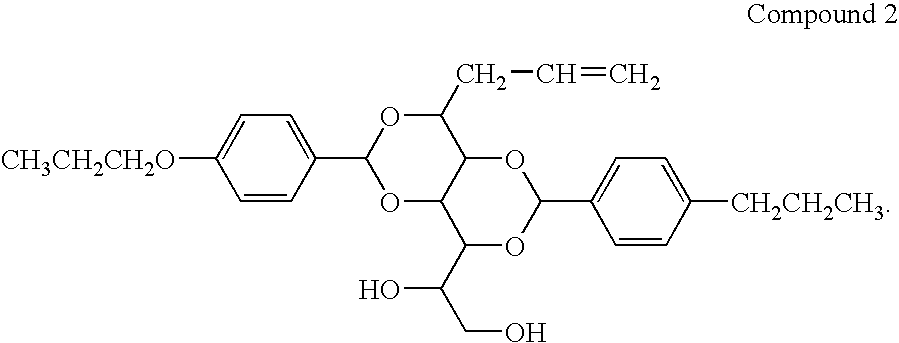Dibenzylidene sorbitol (DBS)-based compounds, compositions and methods for using such compounds
a technology of dibenzylidene sorbitol and dbs, which is applied in the field of dibenzylidene sorbitol (“ dbs”)-based compounds, can solve the problems of undesirable yellowing and plate-out, poor thermal stability, and undesirable yellowing
- Summary
- Abstract
- Description
- Claims
- Application Information
AI Technical Summary
Benefits of technology
Problems solved by technology
Method used
Image
Examples
example 1
1-Allyl Sorbitol
[0058]A three liter three-necked round bottom flask, equipped with heating mantle, stirrer, nitrogen inlet, and condensor, was charged with 900 mL of ethanol, 150 mL of water, 180 g (1.00 mole) of D-glucose, 119 g (1.00 mole) of tin powder (−100 mesh), and 121 g (1.00 mole) of allyl bromide. The mixture was stirred and slowly heated at 60° C. The gray suspension was stirred at this temperature for 24 hours, in which time the reaction mixture turned a light yellow color. Heat was removed and the mixture was allowed to cool to room temperature. The reaction was neutralized to pH=7 by adding approximately 200 ml of 5M NaOH aqueous solution. The suspension was filtered to remove solids, and the yellow solution was decolorized with multiple treatments of activated carbon. The activated carbon was removed by filtration, and the solvent was removed by rotary evaporation to isolate a white syrup. Typical yield was 200 g with a threo-erythro ratio of 6:1, based on GC-MS. The ...
example 4
1-Propyl Sorbitol
[0063]30 g (0.135 mol) of 1-allyl sorbitol syrup (produced as in example 1) was dissolved in 300 ml ethanol. 1.0 g of platinum (5% weight on activated carbon) was added and the mixture was hydrogenated at room temperature with hydrogen pressure at 60 psi. The reaction was stopped until no hydrogen pressure drop was observed. The solid was filtered. The allyl group of the solution was completely converted to propyl group based on NMR.
EXAMPLE 5
Bis-1,3,2,4-(4′-propylbenzylidene)-1-Propyl Sorbitol
[0064]
[0065]A one liter reaction kettle, equipped with a stirrer and nitrogen inlet, was charged with the propyl sorbitol ethanol solution. 40 g (0.27 mol) of 4-propylbenzaldehyde, and 2.6 g of p-toulenesulfonic acid monohydrate was added to the reaction vessel. The clear solution was stirred for 24 hours, during which time a significant amount of white precipitate formed. The white powder was isolated by filtration and washed with 250 ml of 1 M NaOH aqueous solution. The white...
example 6
Bis-1,3,2,4-(4′-propoxylbenzylidene)-1-Propyl Sorbitol
[0066]
[0067]25 g (0.15 mol) of 4-propoxybenzaldehyde was added to a solution of 17.0 g (0.076 mol) of propyl sorbitol (produced in Example 4) in 200 ml of methanol, followed with 1.5 g of p-toulenesulfonic acid monohydrate. The reaction was stirred at room temperature overnight. The resultant solid was collected by filtration, washed with aqueous KOH solution until pH>10. The suspension was heated to boiling, then filtered. The white powder was washed with 7×500 ml of boiling water. The washed powder dried overnight. The white powder was then stirred in 500 mL of cyclohexane, heated until boiling, filtered, and washed with 2×250 ml of boiling cyclohexane. The isolated white powder was dried in a vacuum oven to give 22.3 g of product, m.p. 215-217° C. The purity was above 99%, based on GC-MS. 1H NMR(500 MHz, DMSO-d6, ppm): 0.90-0.93 (t, 3H, —CH2CH2CH3), 0.95-0.98 (m, 6H, —OCH2CH2CH3), 1.36-1.47 (m, 2H, —CH2CH2CH3), 1.53-1.60 (m, 2...
PUM
| Property | Measurement | Unit |
|---|---|---|
| haze | aaaaa | aaaaa |
| temperature | aaaaa | aaaaa |
| hydrogen pressure | aaaaa | aaaaa |
Abstract
Description
Claims
Application Information
 Login to View More
Login to View More - R&D
- Intellectual Property
- Life Sciences
- Materials
- Tech Scout
- Unparalleled Data Quality
- Higher Quality Content
- 60% Fewer Hallucinations
Browse by: Latest US Patents, China's latest patents, Technical Efficacy Thesaurus, Application Domain, Technology Topic, Popular Technical Reports.
© 2025 PatSnap. All rights reserved.Legal|Privacy policy|Modern Slavery Act Transparency Statement|Sitemap|About US| Contact US: help@patsnap.com



